Combined Effect of In Situ Stress Level and Bedding Anisotropy on Hydraulic Fracture Vertical Growth in Deep Marine Shale Revealed via CT Scans and Acoustic Emission
Abstract
:1. Introduction
2. Materials and Methods
2.1. Shale Sample Preparation
2.2. Experimental Setup
3. Results and Discussion
3.1. Characteristics of Hydraulic Fracture Geometry
3.2. Quantitatively Analysis of Hydraulic Fracture Networks
3.3. Fluid Pressure Curves and Acoustic Emission Activity
3.4. Comparison of Breakdown Pressure and Acoustic Emission Energy
3.5. Analysis of Sample Deformation during Hydraulic Fracturing
4. Conclusions
- (1)
- The increase in the in situ stress level and bedding inclination significantly decreased the hydraulic fracture area and fracture network index. The hydraulic fracture area under a higher stress level (σ1 = 50 MPa, σ3 = 40 MPa) was about 13%~23% smaller than that created under the lower stress level (σ1 = 30 MPa, σ3 = 20 MPa) when the bedding angle was smaller than 60°. Smaller stress levels (σ1 = 30MPa, σ3 = 20 MPa) and bedding inclinations (α = 0°, 30°) were favorable for creating complex fractures.
- (2)
- The bedding orientation significantly influenced the hydraulic fracture initiation and propagation process. For the shale sample with bedding planes normal to the maximum principal stress (σ1), the time from micro-crack generation to physical breakdown was about 61 s. When the bedding orientation changed from the horizontal to the vertical position, the fracture process was comparatively accelerated. The increasing stress level significantly increased the breakdown pressure. In particular, the fracturing of shale samples with bedding angles of 0° and 30° required higher fluid pressure and released more energy than samples with larger bedding inclinations.
- (3)
- The maximum radial deformation of the shale sample decreased by about 46%~81% when the confining pressure increased from 20 MPa to 40 MPa, suggesting the reduction of the hydraulic fracture opening extent under a higher in situ stress level.
Author Contributions
Funding
Data Availability Statement
Conflicts of Interest
References
- Chang, C.; Tao, S.; Wang, X.; Liu, C.; Yu, W.; Miao, J. Post-frac evaluation of deep shale gas wells based on a new geology-engineering integrated workflow. Geoenergy Sci. Eng. 2023, 231, 212228. [Google Scholar] [CrossRef]
- Long, S.; Feng, D.; Li, F.; Du, W. Prospect analysis of the deep marine shale gas exploration and development in the Sichuan Basin, China. J. Nat. Gas Geosci. 2018, 3, 181–189. [Google Scholar] [CrossRef]
- Xu, S.; Liu, R.; Hao, F.; Engelder, T.; Yi, J.; Zhang, B.; Shu, Z. Complex rotation of maximum horizontal stress in the Wufeng-Longmaxi Shale on the eastern margin of the Sichuan Basin, China: Implications for predicting natural fractures. Mar. Petrol. Geol. 2019, 109, 519–529. [Google Scholar] [CrossRef]
- Zhang, X.; Wang, R.; Shi, W.; Hu, Q.; Xu, X.; Shu, Z.; Yang, Y.; Feng, Q. Structure- and lithofacies-controlled natural fracture developments in shale: Implications for shale gas accumulation in the Wufeng-Longmaxi Formations, Fuling Field, Sichuan Basin, China. Geoenergy Sci. Eng. 2023, 223, 211572. [Google Scholar] [CrossRef]
- Chen, H.; Meng, X.; Niu, F.; Tang, Y.; Yin, C.; Wu, F. Microseismic monitoring of stimulating shale gas reservoir in SW China: 2. Spatial clustering controlled by the preexisting faults and fractures. J. Geophys. Res. Solid Earth 2018, 123, 1659–1672. [Google Scholar] [CrossRef]
- Lin, C.; He, J.; Li, X.; Wan, X.; Zheng, B. An Experimental Investigation into the effects of anisotropy of shale on hydraulic fracture propagation. Rock Mech. Rock Eng. 2017, 50, 543–554. [Google Scholar] [CrossRef]
- Gehne, S.; Benson, P.M.; Koor, N.; Dobson, K.J.; Enfield, M.; Barber, A. Seisom-mechanical response of anisotropic rocks under hydraulic fracture conditions: New experimental insights. J. Geophys. Res. Solid Earth 2019, 124, 9562–9579. [Google Scholar] [CrossRef]
- Li, L.; Tan, J.; Wood, D.A.; Zhao, Z.; Becker, D.; Lyu, Q.; Shu, B.; Chen, H. A review of the current status of induced seismicity monitoring for hydraulic fracturing in unconventional tight oil and gas reservoirs. Fuel 2019, 242, 195–210. [Google Scholar] [CrossRef]
- Eaton, D.W.; van der Baan, M.; Birkelo, B.; Tary, J.B. Scaling relations and spectral characteristics of tensile microseisms: Evidence for opening/closing cracks during hydraulic fracturing. Geophys. J. Int. 2014, 196, 1844–1857. [Google Scholar] [CrossRef]
- Stanek, F.; Eisner, L. Seismicity Induced by Hydraulic Fracturing in Shales: A Bedding Plane Slip Model. J. Geophys. Res. Solid Earth 2017, 122, 7912–7926. [Google Scholar] [CrossRef]
- Wutherch, K.; Walker, K.; Aso, I.; Ajayi, B.; Cannon, T. Evaluating an engineered completion design in the Marcellus shale using microseismic monitoring. In Proceedings of the SPE Annual Technical Conference and Exhibition, San Antonio, TX, USA, 8–10 October 2012. [Google Scholar]
- Ma, X.; Zoback, M.D. Lithology-controlled stress variations and pad-scale faults: A case study of hydraulic fracturing in the Woodford Shale, Oklahoma. Geophysics 2017, 82, 35–44. [Google Scholar] [CrossRef]
- Goodfellow, S.D.; Young, R.P. A laboratory acoustic emission experiment under in situ conditions. Geophys. Res. Lett. 2014, 41, 3422–3430. [Google Scholar] [CrossRef]
- Triantis, D.; Pasiou, E.D.; Stavrakas, I.; Kourkoulis, S.K. Hidden Affinities between Electric and Acoustic Activities in Brittle Materials at Near-Fracture Load Levels. Rock Mech. Rock Eng. 2022, 55, 1325–1342. [Google Scholar] [CrossRef]
- Triantis, D.; Stavrakas, I.; Loukidis, A.; Pasiou, E.D.; Kourkoulis, S.K. Exploring the acoustic activity in brittle materials in terms of the position of the acoustic sources and the power of the acoustic signals—Part I: Founding the approach. Forces Mech. 2022, 7, 100088. [Google Scholar] [CrossRef]
- Triantis, D.; Stavrakas, I.; Loukidis, A.; Pasiou, E.D.; Kourkoulis, S.K. Spatio-Temporal Distribution of the Sources of Acoustic Events in Notched Fiber-Reinforced Concrete Beams under Three-Point Bending. Materials 2023, 16, 5118. [Google Scholar] [CrossRef]
- Triantis, D.; Loukidis, A.; Stavrakas, I.; Pasiou, E.D.; Kourkoulis, S.K. Attenuation of the Acoustic Activity in Cement Beams under Constant Bending Load Closely Approaching the Fracture Load. Foundations 2022, 2, 590–606. [Google Scholar] [CrossRef]
- Guo, P.; Li, X.; Li, S.; He, J.; Mao, T.; Hu, Y.; Zheng, B. Experimental Investigation of Simultaneous and Asynchronous Hydraulic Fracture Growth from Multiple Perforations in Shale Considering Stress Anisotropy. Rock Mech. Rock Eng. 2023. [Google Scholar] [CrossRef]
- Abe, A.; Kim, T.W.; Horne, R.N. Laboratory hydraulic stimulation experiments to investigate the interaction between newly formed and preexisting fractures. Int. J. Rock Mech. Min. Sci. 2021, 141, 104665. [Google Scholar] [CrossRef]
- Guo, P.; Li, X.; Li, S.; Yang, W.; Wu, Y.; Li, G. Quantitative analysis of anisotropy effect on hydrofracturing efficiency and process in shale using X-ray computed tomography and acoustic emission. Rock Mech. Rock Eng. 2021, 54, 5715–5730. [Google Scholar] [CrossRef]
- Guo, P.; Li, X.; Yang, W.; Mao, T. Experimental study on hydrofracture propagation through perforated wellbore in naturally fractured Guanyinqiao calcareous mudstone under true triaxial stress. J. Nat. Gas. Sci. Eng. 2022, 99, 104415. [Google Scholar] [CrossRef]
- Wang, J.; Xie, H.; Li, C. Anisotropic failure behaviour and breakdown pressure interpretation of hydraulic fracturing experiments on shale. Int. J. Rock. Mech. Min. Sci. 2021, 142, 104478. [Google Scholar] [CrossRef]
- Zhao, H.; Liang, B.; Sun, W.; Hu, Z.; Ma, Y.; Liu, Q. Effect of hydrostatic pressure on hydraulic fracturing properties of shale using X-ray computed tomography and acoustic emission. J. Petrol. Sci. Eng. 2022, 215, 110725. [Google Scholar] [CrossRef]
- Wang, Y.; Yan, M.Q.; Song, W.B. The effect of cyclic stress amplitude on macro-meso failure of rock under triaxial confining pressure unloading. axial loads. Fatigue Fract. Eng. Mater. Struct. 2023, 47, 3008–3025. [Google Scholar]
- Wang, Y.; Cao, Z.; Li, P.; Yi, X. On the fracture and energy characteristics of granite containing circular cavity under variable frequency-amplitude fatigue loads. Theor. Appl. Fract. Mech. 2023, 125, 103872. [Google Scholar] [CrossRef]
- Heng, S.; Liu, X.; Li, X.; Zhang, X.; Yang, C. Experimental and numerical study on the non-planar propagation of hydraulic fractures in shale. J. Petrol. Sci. Eng. 2019, 179, 410–426. [Google Scholar] [CrossRef]
- Zheng, H.; Pu, C.; Sun, C. Study on the interaction between hydraulic fracture and natural fracture based on extended finite element method. Eng. Fract. Mech. 2020, 230, 106981. [Google Scholar] [CrossRef]
- Fisher, M.K.; Wright, C.A.; Davidson, B.M.; Goodwin, A.K.; Fielder, E.O.; Buckler, W.S.; Steinsberger, N.P. Integrating fracture mapping technologies to optimize stimulations in the Barnett shale. In Proceedings of the SPE Annual Technical Conference and Exhibition, San Antonio, TX, USA, 29 September–2 October 2002. [Google Scholar]
- Mayerhofer, M.J.; Lolon, E.P.; Warpinski, N.R.; Cipolla, C.L.; Walser, D.; Rightmire, C.M. What is stimulated reservoir volume? SPE Prod. Oper. 2010, 25, 89–98. [Google Scholar] [CrossRef]
- Warpinski, N.R.; Mayerhofer, M.J.; Vincent, M.C.; Cipolla, C.L.; Lolon, E.P. Stimulating unconventional reservoirs: Maximizing network growth while optimizing fracture conductivity. J. Can. Petrol. Technol. 2009, 48, 39–51. [Google Scholar] [CrossRef]
- Tan, P.; Jin, Y.; Han, K.; Hou, B.; Chen, M.; Guo, X.; Gao, J. Analysis of hydraulic fracture initiation and vertical propagation behavior in laminated shale formation. Fuel 2017, 206, 482–493. [Google Scholar] [CrossRef]
- Zhang, R.; Hou, B.; Han, H.; Fan, M.; Chen, M. Experimental investigation on fracture morphology in laminated shale formation by hydraulic fracturing. J. Petrol. Sci. Eng. 2019, 177, 442–451. [Google Scholar] [CrossRef]
- Fisher, K.; Warpinski, N. Hydraulic-Fracture-Height Growth: Real Data. SPE Prod. Oper. 2012, 27, 8–19. [Google Scholar] [CrossRef]
- Zheng, S.; Lin, M.; Jiang, W.; Qiu, X.; Chen, Z. New method of in situ high-resolution experiments and analysis of fracture networks formed by hydraulic fracturing. J. Petrol. Sci. Eng. 2022, 217, 110849. [Google Scholar] [CrossRef]
- Fisher, M.K.; Heinze, J.R.; Harris, C.D.; Davidson, B.M.; Wright, C.A.; Dunn, K.P. Optimizing horizontal completion techniques in the Barnett shale using microseismic fracture mapping. In Proceedings of the SPE Annual Technical Conference and Exhibition, Houston, TX, USA, 26–29 September 2004. [Google Scholar]
- Yew, C.H.; Weng, X. Mechanics of Hydraulic Fracturing, 2nd ed.; Gulf Professional Publishing: Houston, TX, USA, 2015. [Google Scholar]
- Hossain, M.M.; Rahman, M.K.; Rahman, S.S. Hydraulic fracture initiation and propagation: Roles of wellbore trajectory, perforation and stress regimes. J. Petrol. Sci. Eng. 2000, 27, 129–149. [Google Scholar] [CrossRef]
- He, J.; Lin, C.; Li, X.; Zhang, Y.; Chen, Y. Initiation, propagation, closure and morphology of hydraulic fractures in sandstones cores. Fuel 2017, 208, 65–70. [Google Scholar] [CrossRef]
- Aslannezhad, M.; Kalantariasl, A.; You, Z.; Iglauer, S.; Keshavarz, A. Micro-proppant placement in hydraulic and natural fracture stimulation in unconventional reservoirs: A review. Energy Rep. 2021, 7, 8997–9022. [Google Scholar] [CrossRef]
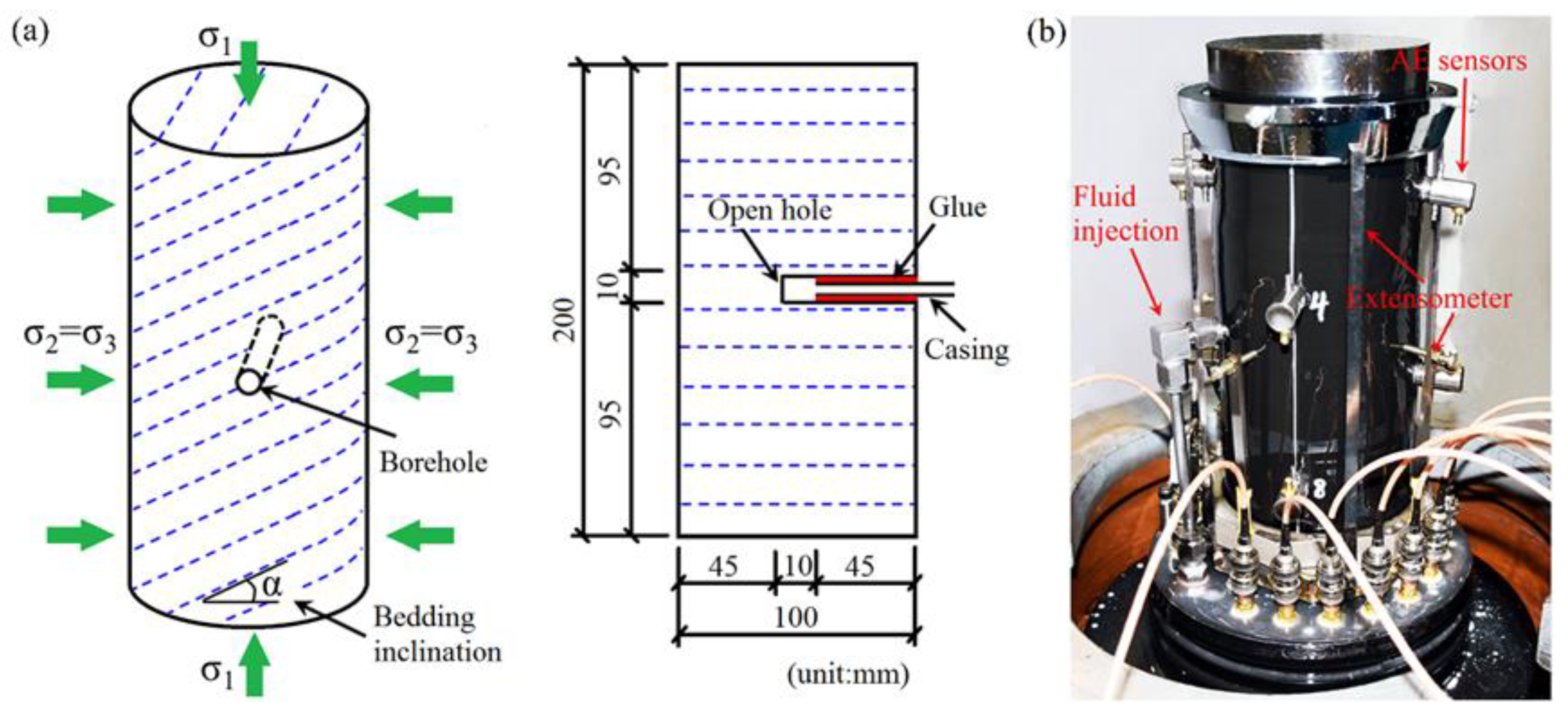
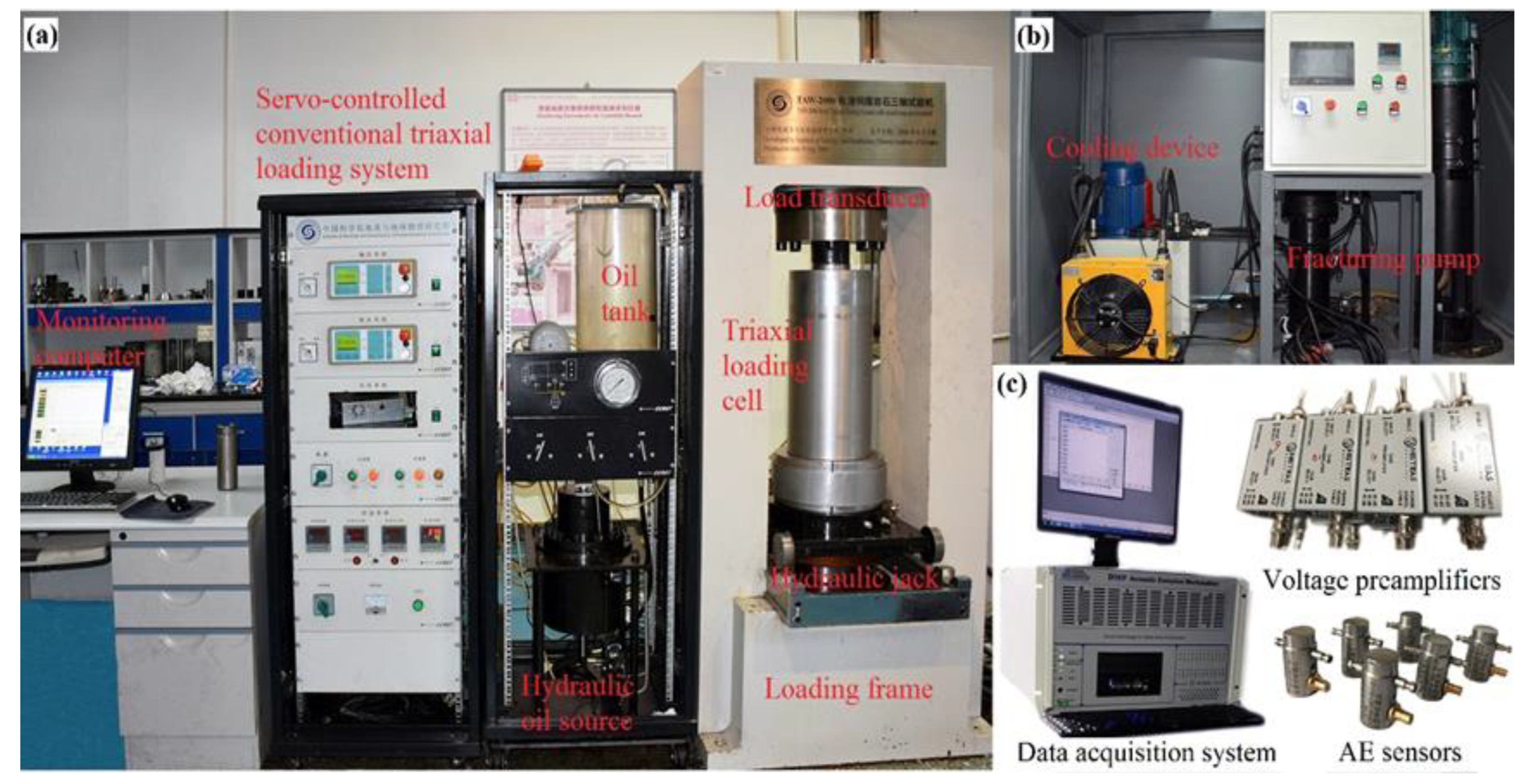
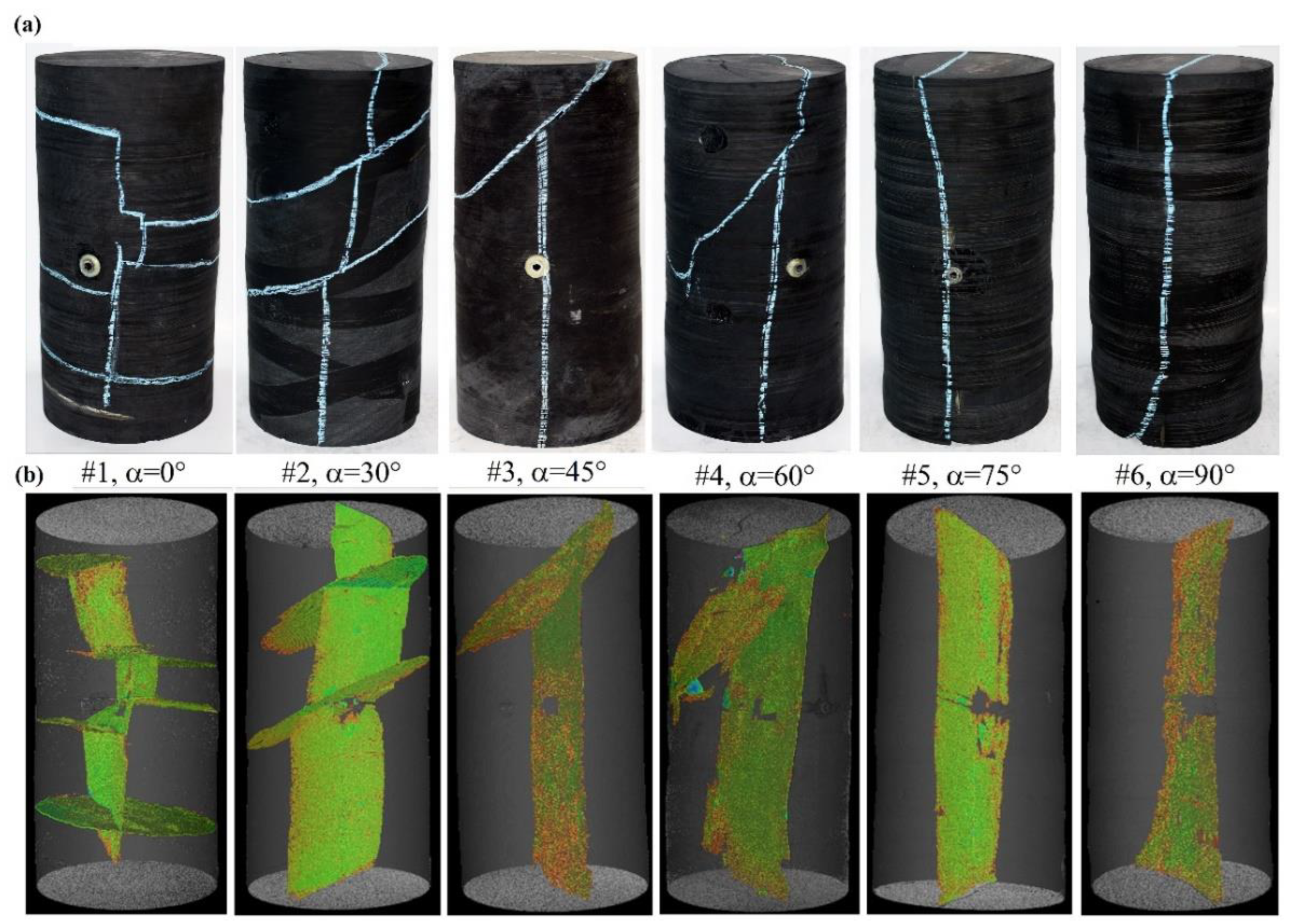
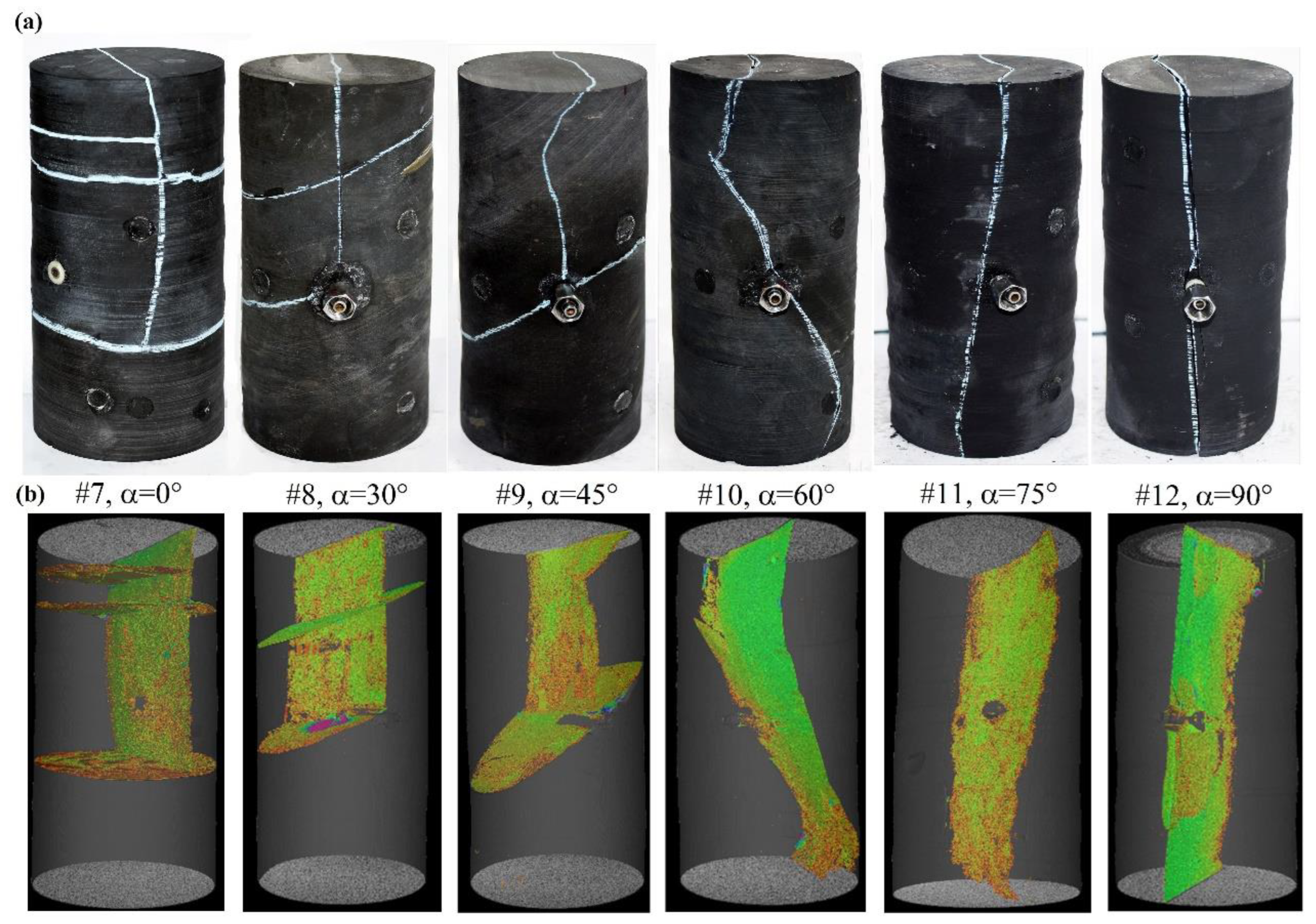



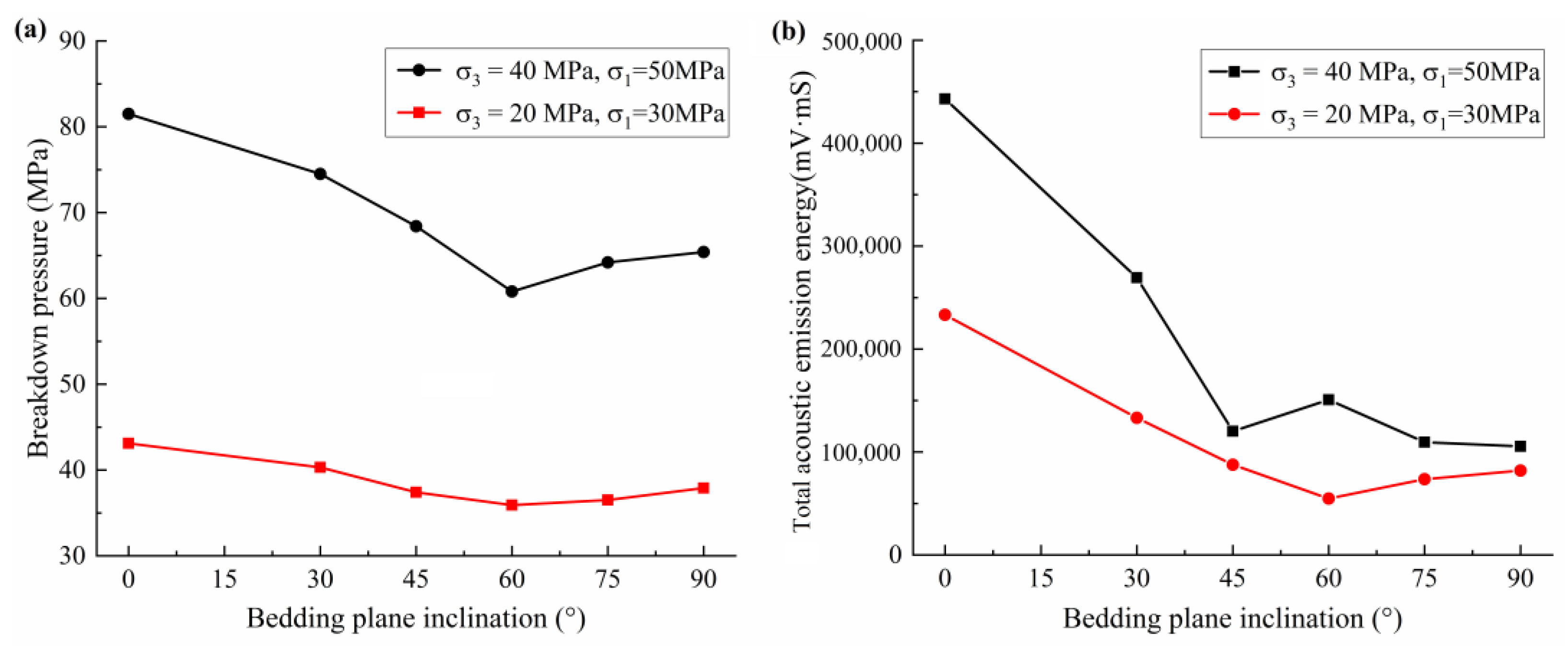
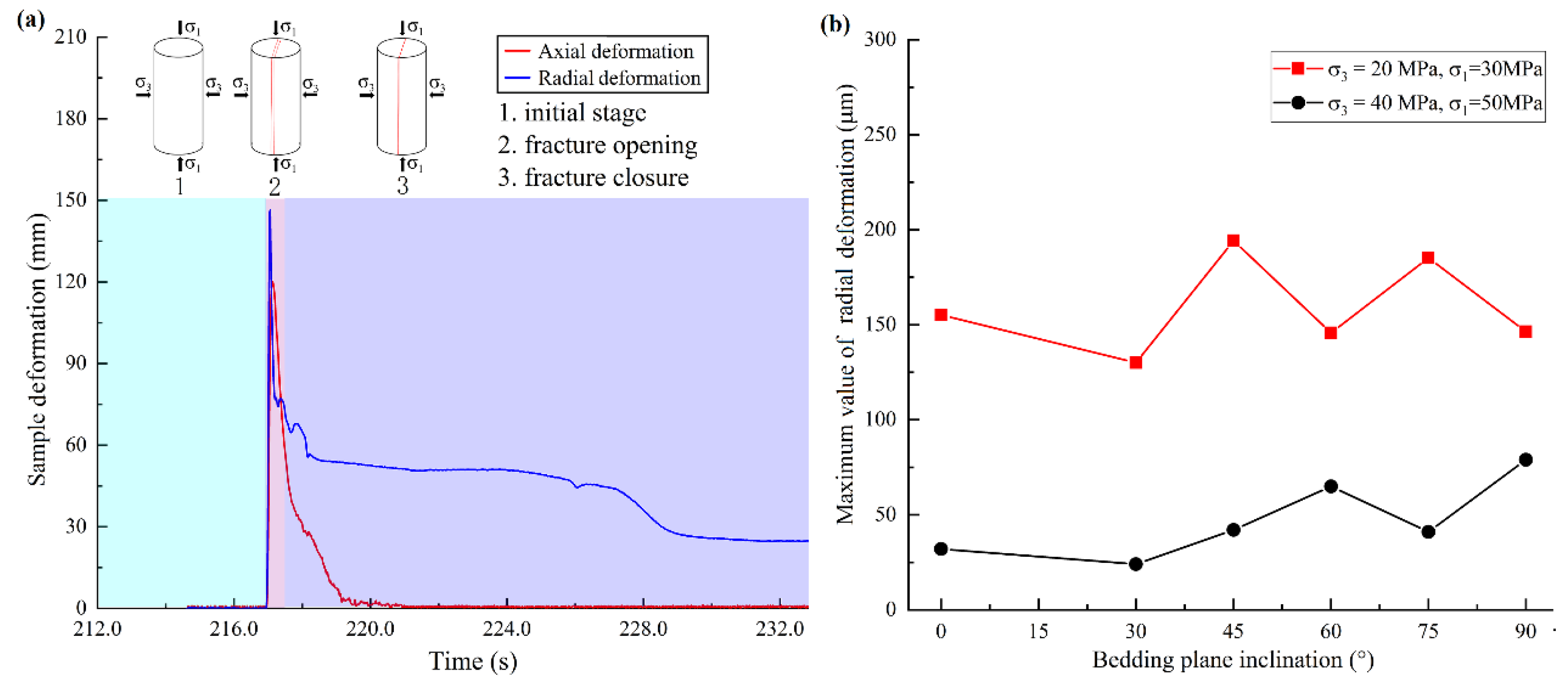
| Sample Number | Bedding Inclination (°) | Confining Pressure (MPa) | Axial Stress (MPa) | Stress Difference (MPa) | Injection Rate (mL/min) | Fluid Viscosity (mPa·s) |
|---|---|---|---|---|---|---|
| #1 | 0 | 20 | 30 | 10 | 30 | 1 |
| #2 | 30 | 20 | 30 | 10 | 30 | 1 |
| #3 | 45 | 20 | 30 | 10 | 30 | 1 |
| #4 | 60 | 20 | 30 | 10 | 30 | 1 |
| #5 | 75 | 20 | 30 | 10 | 30 | 1 |
| #6 | 90 | 20 | 30 | 10 | 30 | 1 |
| #7 | 0 | 40 | 50 | 10 | 30 | 1 |
| #8 | 30 | 40 | 50 | 10 | 30 | 1 |
| #9 | 45 | 40 | 50 | 10 | 30 | 1 |
| #10 | 60 | 40 | 50 | 10 | 30 | 1 |
| #11 | 75 | 40 | 50 | 10 | 30 | 1 |
| #12 | 90 | 40 | 50 | 10 | 30 | 1 |
Disclaimer/Publisher’s Note: The statements, opinions and data contained in all publications are solely those of the individual author(s) and contributor(s) and not of MDPI and/or the editor(s). MDPI and/or the editor(s) disclaim responsibility for any injury to people or property resulting from any ideas, methods, instructions or products referred to in the content. |
© 2023 by the authors. Licensee MDPI, Basel, Switzerland. This article is an open access article distributed under the terms and conditions of the Creative Commons Attribution (CC BY) license (https://creativecommons.org/licenses/by/4.0/).
Share and Cite
Guo, P.; Li, X.; Li, S.; Mao, T. Combined Effect of In Situ Stress Level and Bedding Anisotropy on Hydraulic Fracture Vertical Growth in Deep Marine Shale Revealed via CT Scans and Acoustic Emission. Energies 2023, 16, 7270. https://doi.org/10.3390/en16217270
Guo P, Li X, Li S, Mao T. Combined Effect of In Situ Stress Level and Bedding Anisotropy on Hydraulic Fracture Vertical Growth in Deep Marine Shale Revealed via CT Scans and Acoustic Emission. Energies. 2023; 16(21):7270. https://doi.org/10.3390/en16217270
Chicago/Turabian StyleGuo, Peng, Xiao Li, Shouding Li, and Tianqiao Mao. 2023. "Combined Effect of In Situ Stress Level and Bedding Anisotropy on Hydraulic Fracture Vertical Growth in Deep Marine Shale Revealed via CT Scans and Acoustic Emission" Energies 16, no. 21: 7270. https://doi.org/10.3390/en16217270





